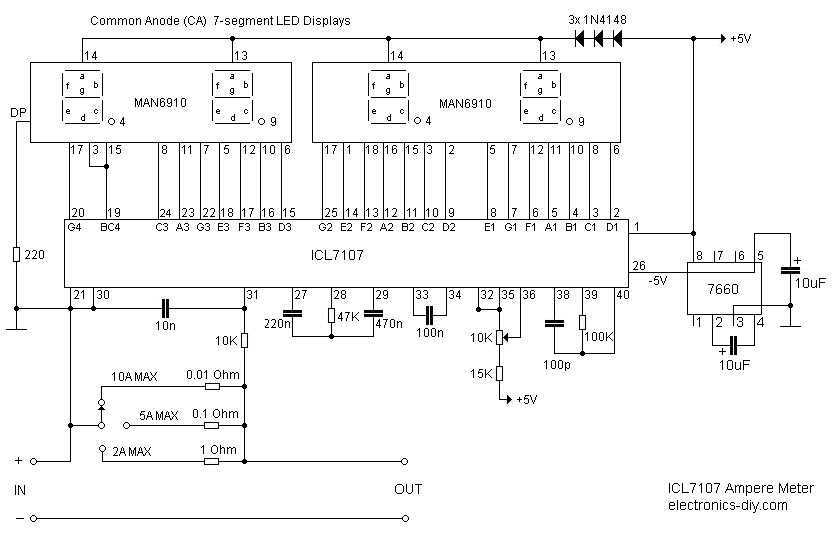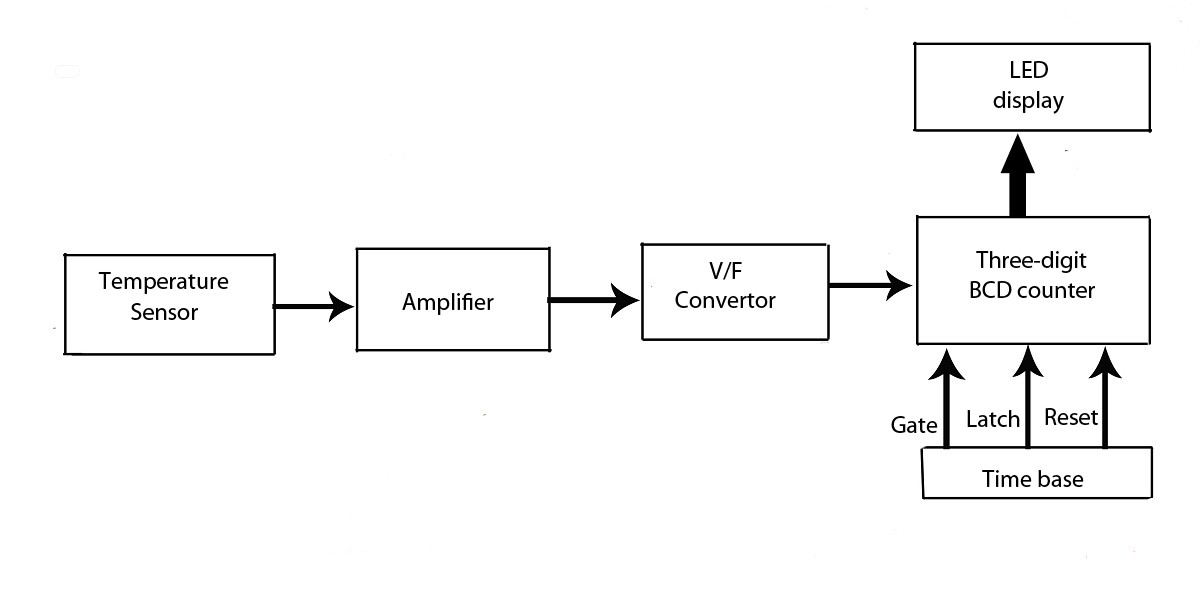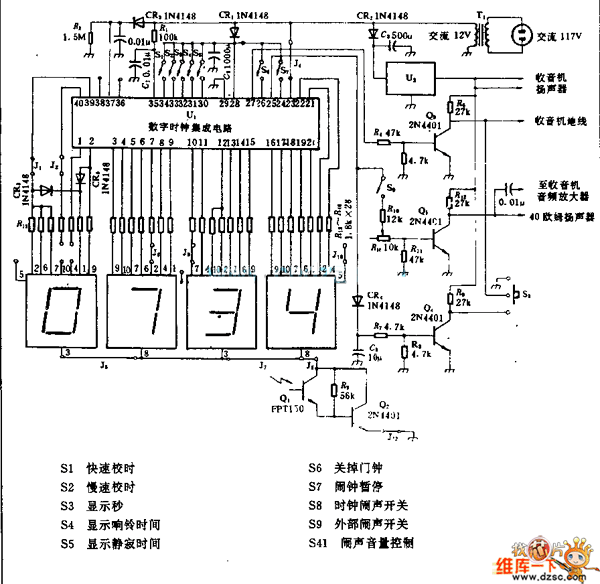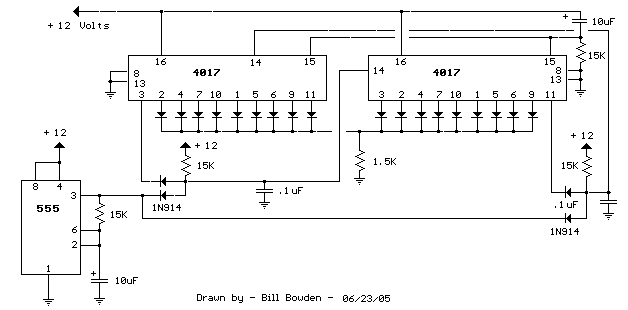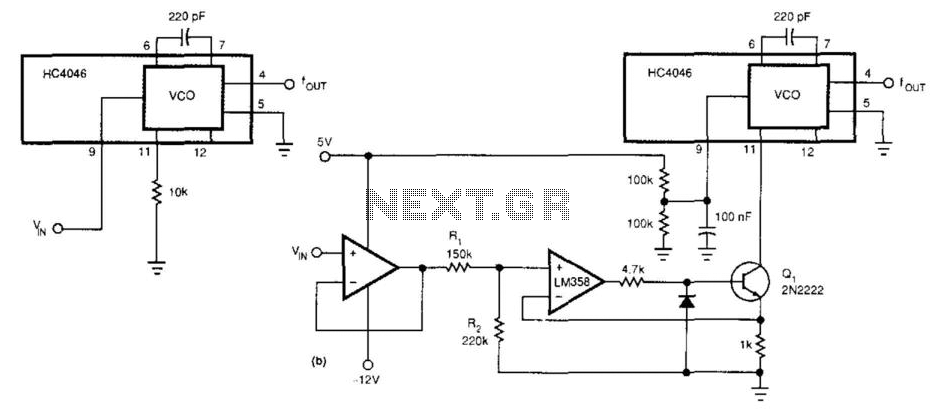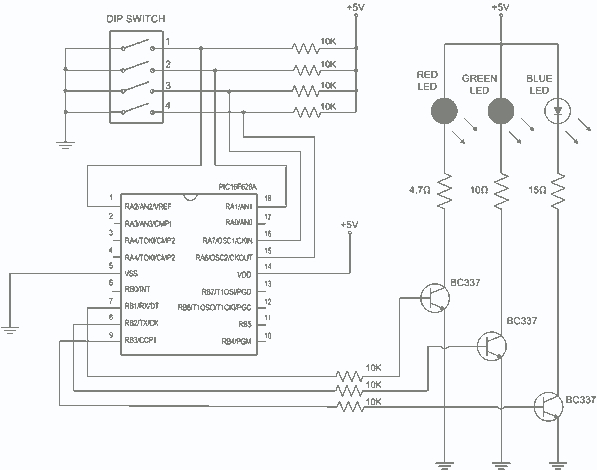
72 LED Clock
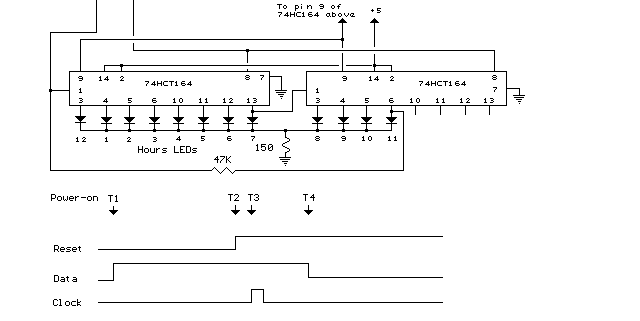
In the circuit below, 60 individual LEDs indicate the minutes of a clock, while 12 LEDs represent the hours. The power supply and timing circuitry are similar to those described in the previous 28 LED clock circuit. The minute section consists of eight 74HCT164 shift registers connected in a cascade configuration, allowing a single bit to circulate through the 60 stages to indicate the current minute. Only two of the minute shift registers are shown connected to 16 LEDs. Pin 13 of each register connects to pin 1 of the next for seven registers, while pin 6 of the eighth register connects back to pin 1 of the first register using a 47K resistor. Pins 2, 9, 8, 14, and 7 of all eight minute registers (74HC164) should be connected in parallel. The hour section includes two 8-bit shift registers that function similarly to display one of the 12 hours. Pin 9 of all 74HCT164s (for both hours and minutes) should be connected together. For operation at 50 Hertz, the timing section can be modified as illustrated in the lower drawing labeled "50 Hertz LED Clock Time Base." This modification requires an additional IC (74HC30) to decode 7 bits of the counter instead of 4. The two unused dual-input NAND gates (1/2 74HC00) in the 50 Hertz modification should have their inputs grounded. Upon power application, a single "1" bit is loaded into the first stage of both the minute and hour registers. This is achieved by sending a momentary low reset signal to all registers (at pin 9) and utilizing a NAND gate to prevent any clock transitions at pin 8 of the minute registers. Simultaneously, a high level is applied to the data input lines of both the minute and hour registers at pin 1. A single positive-going clock pulse (at pin 8) is generated at the conclusion of the reset signal, loading a high level into the first stage of the minute register. The rising edge of the first stage output at pin 3 advances the hour register (at pin 8), also loading a single bit into the hour register. Power should remain off for approximately 3 seconds before being re-applied to allow the filter and timing capacitors to discharge. A 1K bleeder resistor is used across the 1000uF filter capacitor to facilitate this discharge in about 3 seconds. The timing diagram illustrates the power-on sequence where T1 marks the time power is applied and the reset signal begins, T2 signifies the end of the reset signal, T3 denotes the clock signal moving a high level at pin 1 into the first register, and T4 indicates the end of the data signal. The time delay from T2 to T3 is exaggerated in the drawing and is actually a very short duration, only reflecting the propagation delay through the inverter and gate. Two momentary push buttons can be employed to set the correct time, with the button labeled "M" incrementing the minutes slowly, and the button labeled "H" incrementing the hours much faster. The hours should be set first, followed by the minutes.
The circuit utilizes a combination of 74HCT164 shift registers to create a versatile clock display system. The minute display is achieved through a cascading arrangement of eight shift registers, allowing for a seamless transition between minutes as the single bit circulates through the 60 stages. The interconnections between the registers are crucial, with the cascading nature ensuring that the output of one register feeds into the next. The use of a 47K resistor for feedback from the eighth to the first register is essential for maintaining the continuity of the minute count.
The hour section employs a similar architecture with two 8-bit shift registers, allowing for the display of hours from 1 to 12. The synchronization of the hour and minute registers is facilitated by connecting pin 9 of all registers together, ensuring that the clock operates in unison.
For applications requiring a 50 Hertz operation, the circuit can be modified to accommodate a more complex timing structure, necessitating the additional 74HC30 IC. This allows for the decoding of 7 bits instead of 4, enhancing the precision of the clock's timing function. The grounding of unused NAND gates ensures that the circuit remains stable and free from noise or interference.
The power-on sequence is carefully designed to initialize the registers correctly. The use of a momentary low reset signal coupled with a NAND gate effectively locks out clock transitions during the initialization phase, ensuring that the registers are loaded with the correct initial state. The timing diagram serves as a visual representation of this sequence, detailing the critical moments during the power application and reset process.
User interaction with the clock is facilitated through two push buttons, allowing for easy adjustments of the time settings. The design prioritizes user-friendliness, ensuring that the hours can be set quickly before fine-tuning the minutes. Overall, this circuit design exemplifies a comprehensive approach to creating a functional and user-friendly clock display system using shift registers and LED indicators.In the circuit below, 60 individual LEDs are used to indicate the minutes of a clock and 12 LEDs indicate hours. The power supply and time base circuitry is the same as described in the 28 LED clock circuit above. The minutes section of the clock is comprised of eight 74HCT164 shift registers cascaded so that a single bit can be recirculated through the 60 stages indicating
the appropriate minute of the hour. Only two of the minutes shift registers are shown connected to 16 LEDs. Pin 13 of each register connects to pin 1 of the next for 7 registers. Pin 6 of the 8th register should connect back to pin 1 of the first register using the 47K resistor. Pins 2, 9, 8, 14 and 7 of all 8 minutes registers (74HC164) should be connected in parallel (pin 8 to pin 8, pin 9 to pin 9, etc. ). The hours section contains two 8 bit shift registers and works the same way as the minutes to display 1 of 12 hours.
Pin 9 of all 74HCT164s (hours and minutes) should be connected together. For 50 Hertz operation, the time base section of the circuit can be modified as shown in the lower drawing labeled "50 Hertz LED Clock Time Base". You will need an extra IC (74HC30) to do this since it requires decoding 7 bits of the counter instead of 4.
The two dual input NAND gates (1/2 74HC00) that are not used in the 50 Hertz modification should have their inputs connected to ground. When power is applied, a single "1" bit is loaded into the first stage of both the minutes and hours registers.
To accomplish this, a momentary low reset signal is sent to all the registers (at pin 9) and also a NAND gate to lock out any clock transitions at pin 8 of the minutes registers. At the same time, a high level is applied to the data input lines of both minutes and hours registers at pin 1.
A single positive going clock pulse (at pin 8) is generated at the end of the reset signal which loads a high level into the first stage of the minutes register. The rising edge of first stage output at pin 3 advances the hours (at pin 8) and a single bit is also loaded into the hours register.
Power should remain off for about 3 seconds or more before being re-applied to allow the filter and timing capacitors to discharge. A 1K bleeder resistor is used across the 1000uF filter capacitor to discharge it in about 3 seconds. The timing diagram illustrates the power-on sequence where T1 is the time power is applied and beginning of the reset signal, T2 is the end of the reset signal, T3 is the clock signal to move a high level at pin 1 into the first register, T4 is the end of the data signal.
The time delay from T2 to T3 is exaggerated in the drawing and is actually a very short time of just the propagation delay through the inverter and gate. Two momentary push buttons can be used to set the correct time. The button labeled "M" will increment the minutes slowly and the one labled "H" much faster so that the hours increment slowly.
The hours should be set first, followed by minutes. 🔗 External reference
The circuit utilizes a combination of 74HCT164 shift registers to create a versatile clock display system. The minute display is achieved through a cascading arrangement of eight shift registers, allowing for a seamless transition between minutes as the single bit circulates through the 60 stages. The interconnections between the registers are crucial, with the cascading nature ensuring that the output of one register feeds into the next. The use of a 47K resistor for feedback from the eighth to the first register is essential for maintaining the continuity of the minute count.
The hour section employs a similar architecture with two 8-bit shift registers, allowing for the display of hours from 1 to 12. The synchronization of the hour and minute registers is facilitated by connecting pin 9 of all registers together, ensuring that the clock operates in unison.
For applications requiring a 50 Hertz operation, the circuit can be modified to accommodate a more complex timing structure, necessitating the additional 74HC30 IC. This allows for the decoding of 7 bits instead of 4, enhancing the precision of the clock's timing function. The grounding of unused NAND gates ensures that the circuit remains stable and free from noise or interference.
The power-on sequence is carefully designed to initialize the registers correctly. The use of a momentary low reset signal coupled with a NAND gate effectively locks out clock transitions during the initialization phase, ensuring that the registers are loaded with the correct initial state. The timing diagram serves as a visual representation of this sequence, detailing the critical moments during the power application and reset process.
User interaction with the clock is facilitated through two push buttons, allowing for easy adjustments of the time settings. The design prioritizes user-friendliness, ensuring that the hours can be set quickly before fine-tuning the minutes. Overall, this circuit design exemplifies a comprehensive approach to creating a functional and user-friendly clock display system using shift registers and LED indicators.In the circuit below, 60 individual LEDs are used to indicate the minutes of a clock and 12 LEDs indicate hours. The power supply and time base circuitry is the same as described in the 28 LED clock circuit above. The minutes section of the clock is comprised of eight 74HCT164 shift registers cascaded so that a single bit can be recirculated through the 60 stages indicating
the appropriate minute of the hour. Only two of the minutes shift registers are shown connected to 16 LEDs. Pin 13 of each register connects to pin 1 of the next for 7 registers. Pin 6 of the 8th register should connect back to pin 1 of the first register using the 47K resistor. Pins 2, 9, 8, 14 and 7 of all 8 minutes registers (74HC164) should be connected in parallel (pin 8 to pin 8, pin 9 to pin 9, etc. ). The hours section contains two 8 bit shift registers and works the same way as the minutes to display 1 of 12 hours.
Pin 9 of all 74HCT164s (hours and minutes) should be connected together. For 50 Hertz operation, the time base section of the circuit can be modified as shown in the lower drawing labeled "50 Hertz LED Clock Time Base". You will need an extra IC (74HC30) to do this since it requires decoding 7 bits of the counter instead of 4.
The two dual input NAND gates (1/2 74HC00) that are not used in the 50 Hertz modification should have their inputs connected to ground. When power is applied, a single "1" bit is loaded into the first stage of both the minutes and hours registers.
To accomplish this, a momentary low reset signal is sent to all the registers (at pin 9) and also a NAND gate to lock out any clock transitions at pin 8 of the minutes registers. At the same time, a high level is applied to the data input lines of both minutes and hours registers at pin 1.
A single positive going clock pulse (at pin 8) is generated at the end of the reset signal which loads a high level into the first stage of the minutes register. The rising edge of first stage output at pin 3 advances the hours (at pin 8) and a single bit is also loaded into the hours register.
Power should remain off for about 3 seconds or more before being re-applied to allow the filter and timing capacitors to discharge. A 1K bleeder resistor is used across the 1000uF filter capacitor to discharge it in about 3 seconds. The timing diagram illustrates the power-on sequence where T1 is the time power is applied and beginning of the reset signal, T2 is the end of the reset signal, T3 is the clock signal to move a high level at pin 1 into the first register, T4 is the end of the data signal.
The time delay from T2 to T3 is exaggerated in the drawing and is actually a very short time of just the propagation delay through the inverter and gate. Two momentary push buttons can be used to set the correct time. The button labeled "M" will increment the minutes slowly and the one labled "H" much faster so that the hours increment slowly.
The hours should be set first, followed by minutes. 🔗 External reference
